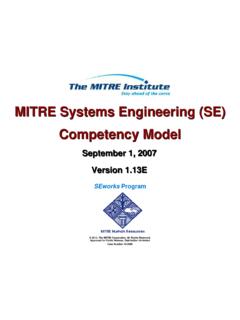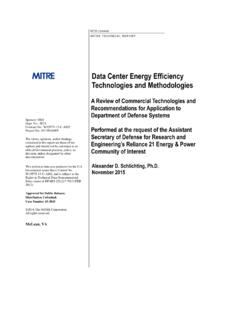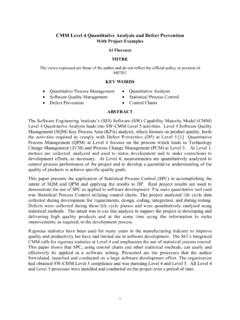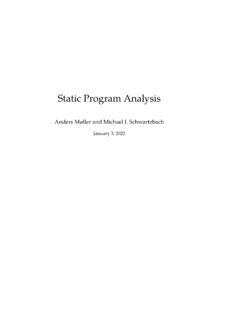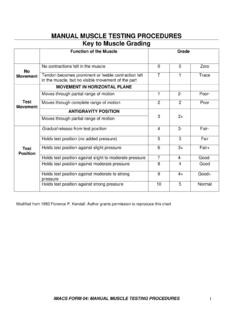Transcription of Finding Cyber Threats with ATT&CK-Based Analytics
1 Finding Cyber Threats with ATT&CK - based Analytics Blake E. Strom Joseph A. Battaglia Michael S. Kemmerer William Kupersanin Douglas P. Miller Craig Wampler Sean M. Whitley Ross D. Wolf June 2017 MTR170202 MITRE TECHNICAL REPORT Dept. No.: J83L Project No.: 0716MM09-AA The views, opinions and/or findings contained in this report are those of The MITRE Corporation and should not be construed as an official government position, policy, or decision, unless designated by other documentation. Approved for Public Release; Distribution Unlimited. Case Number 16-3713. This technical data deliverable was developed using contract funds under Basic Contract No.
2 W15P7T-13-C-A802. 2017 The MITRE Corporation. All rights reserved. ATT&CK and ATT&CK Matrix are trademarks of The MITRE Corporation. Annapolis Junction, MD ii 2017 The MITRE Corporation. All rights reserved. Approved for Public Release; Distribution Unlimited. Case Number 16-3713. Abstract Post-compromise intrusion detection of Cyber adversaries is an important capability for network defenders as adversaries continue to evolve methods for compromising systems and evading common defenses. This paper presents a methodology for using the MITRE ATT&CK framework, a behavioral- based threat model, to identify relevant defensive sensors and build, test, and refine behavioral- based analytic detection capabilities using adversary emulation.
3 This methodology can be applied to enhance enterprise network security through defensive gap analysis, endpoint security product evaluations, building and tuning behavioral Analytics for a particular environment, and performing validation of defenses against a common threat model using a red team emulating known adversary behavior. iii 2017 The MITRE Corporation. All rights reserved. Approved for Public Release; Distribution Unlimited. Case Number 16-3713. This page intentionally left blank. iv 2017 The MITRE Corporation. All rights reserved. Approved for Public Release; Distribution Unlimited. Case Number 16-3713.
4 Acknowledgments We would like to thank the MITRE Cyber security research program and leadership for supporting our research over the years, providing valuable oversight, and enabling the team to break new ground on enterprise detection. Especially Todd Wittbold for the original vision and early leadership that enabled the team to focus on the research and the leadership provided by Ed Sweitzer to keep things on track. Adam Pennington, Xeno Kovah, Frank Duff, Eric Sheesley, Brad Crawford, and Jen Miller-Osborn, Kerry Long, and all the others who shaped FMX s research over the years by articulating the threat, and defining how to detect it more effectively.
5 Their leadership enabled the vision to become a reality. We would also like to thank Desiree Beck, Kelley Burgin, Chris Korban, Jonathan Ferretti, Briana Fischer, Henry Foster, Patrick Freed, Doug Hildebrand, Shaun McCullough, Michael McFail, Joan Peterson, Francis Ripberger, and Marlies Ruck who directly supported the work in various ways. MITRE Annapolis Junction site management, MITRE InfoSec, and MITRE Center for Information and Technology for their understanding and patience as we challenged established policies in the course of our research. The living lab environment, and continual red teaming of the environment would not have been possible without their support.
6 And finally, we would like to acknowledge and thank the National Security Agency Adaptive Cyber Defense Systems research team. They were strong research advocates for incorporating Cyber resilience concepts, participated in experiments conducted within the research environment, and engaged in multiple brainstorming sessions on detection, response, and threat modeling. v 2017 The MITRE Corporation. All rights reserved. 2017 The MITRE Corporation. All rights reserved. Approved for Public Release; Distribution Unlimited. Case Number 16-3713. Table of Contents Introduction .. 1 Frame of Reference .. 2 Shortcomings of Contemporary Approaches for Detection.
7 4 Threat- based Security Approach .. 5 Principle 1: Include Post-Compromise Detection .. 5 Principle 2: Focus on Behavior .. 6 Principle 3: Use a Threat- based Model .. 6 Principle 4: Iterate by Design .. 7 Principle 5: Develop and Test in a Realistic Environment .. 7 ATT&CK .. 9 Post-Compromise Threat- based Modeling .. 9 Tactics .. 10 Techniques .. 12 Operational Use Cases .. 13 ATT&CK- based Analytics Development Method .. 14 Step 1: Identify Behaviors .. 16 Step 2: Acquire Data .. 16 Endpoint Sensing .. 17 Step 3: Develop Analytics .. 20 Step 4: Develop an Adversary Emulation Scenario.
8 21 Scenario Development .. 22 Step 5: Emulate Threat .. 27 Step 6: Investigate Attack .. 27 Step 7: Evaluate Performance .. 28 Real-World Experiences .. 29 Cyber Game Experiences .. 29 Analytic Iteration .. 31 Summary .. 33 References .. 35 Appendix A Details on MITRE s Implementation .. A-1 Example Analytics .. A-1 Sensors .. A-3 Appendix B Scenario Details .. B-1 Scenario 1 .. B-1 Scenario 2 .. B-3 vi 2017 The MITRE Corporation. All rights reserved. Approved for Public Release; Distribution Unlimited. Case Number 16-3713. Table of Figures Figure 1. Five Principles of Threat- based Security.
9 5 Figure 2. The ATT&CK Tactic Categories .. 7 Figure 3. The MITRE ATT&CK Matrix .. 11 Figure 4 ATT&CK- based Analytics Development Method .. 15 Figure 5. Color Coded ATT&CK Matrix Covering Notional Perimeter- based Defenses .. 19 Figure 6. Scenario 1 Plan ATT&CK Matrix .. 24 Figure 7. Scenario 2 ATT&CK Matrix .. 26 1 2017 The MITRE Corporation. All rights reserved. 2017 The MITRE Corporation. All rights reserved. Approved for Public Release; Distribution Unlimited. Case Number 16-3713. Introduction Defending an enterprise network against an advanced persistent threat (APT) remains an increasingly difficult challenge that requires, among other things, advanced technologies and approaches for thwarting adversary goals.
10 In current enterprise networks, it is unlikely that organizations have the ability or the resources to detect and defend against every method an adversary might use to gain access to their networks and systems. Even if an organization s enterprise patching and software compliance program is perfect, an adversary may use a zero-day exploit, or a social engineering attack to gain a foothold in a potential victim s network. Once inside, adversaries hide in the noise and complexity of their target s environment, often using legitimate mechanisms and camouflaging their activities in normal network traffic to achieve their objectives.
